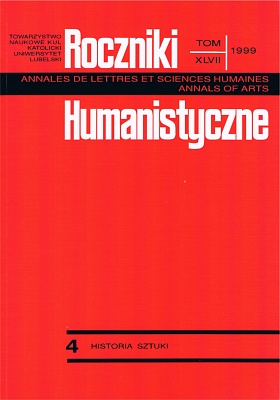Leading Out of Hell. On Jonasz Stern's Art
Abstract
The tenth anniversary of Jonasz Stern's death (1904-1988), though it passed by unnoticed, is a good opportunity to reflect on the rank of his art. The artist accomplished artistic maturity late, for as late as the beginning of the 1960s. It was only then that he managed to show, and that was the essence of his life, brotherhood with nature and death. It was then that his masterpieces were painted, a cycle of assemblages with the use of animal bones, fishbones and skin. In order to understand this art, one should refer to the dramatic life of its author, especially to such war events as his escape from the train transporting people to gas chambers, or his later escape from the firing squad.
After the war, Stern had long sought for his own language of artistic expression. Initially, he was interested in avant garde, yet eventually he spoke with his own voice owing to his experience he had gained from annual canoeing trips he organized with his friends, first on the Vistula and then on the San. Then something happened in his biography, i.e. he had recognized his individual fortune, he managed to fish it out of prior accidental, cruel and senseless events. During the trips, Stern worked as a master of survival art: he caught fish for his friends, cooked them and taught them how to live with nature and trust oneself. The canoeing trips helped him to learn the world of fish, their tastes and way of feeding. It was Stern's programme then to harmonize with the world of matter, the world of life governed by the elementary functions, such as eating and finding food, that is killing. He wished to penetrate matter, to sympathize with it. Therefore fishbones and skin, food rests and despised waste have become his artistic material.
Thus Jonasz Stern's art turned away from the quest after a rhetorical, perfect form and became involved in an apparently terrible programme: to accept the stranger, the mortal enemy and torturer. In order to achieve that, the artist himself becomes a “hunter”. He does not reject the other, for the other is his brother. He becomes a Cain to discover love in himself. The transformation is the sense of the life and art of Jonasz Stern, who by the power of love breaks the course of Evil. The latter becomes a footstool of the throne of Good. Indeed, the artist is an offering doomed to be shot, an incarnation of the raised Abel. This, however, does not eliminate Cain, for he is convinced that if the winners would morally like to stay with themselves, they would not differ from the Nazis seeking for racial purity, i.e. they would be alone among their relatives. The flaw of Cain is in us - this belief makes it that in his works Stern does not accept the role of an offering, hence they are not an expression of protest. His act of forgiveness is the only act in its kind. Perhaps one should not speak about forgiveness at all, but about an attempt to embrace Evil with inconceivable love. An act of true sympathy, and that not only for the victims, but also for the torturers is raised in the oeuvre of Stern to the essence of humanity. The value of that art is, above all, in his ability to lead the onlooker through the hell of the Second World War and lead him out of it without evasion. He does it with full awareness of the most traumatic experiences.
Copyright (c) 1999 Roczniki Humanistyczne

This work is licensed under a Creative Commons Attribution-NonCommercial-NoDerivatives 4.0 International License.





